Home »
Maxus has revealed the long-awaited Maxus eDeliver 5 van at the Commercial Vehicle show.
The latest model in their electric van line-up the eDeliver 5 completes the small to large revamp of their product range which started with the eDeliver 3 compact van and includes eDeliver 7 mid-size and eDeliver 9 large van.
Imported into the UK by Harris Maxus, the eDeliver 5 gets a 64kWh battery returning a 208 mile range, according to the WLTP combined test cycle.
Power comes from a 120kW motor producing 240Nm of torque. The eDeliver 5 will also get a 1200kg payload and come in two roof heights with 6.m3 or 7.6m3 load volume.
Prices will start from £34,000 with order books open immediately. Production will begin next month at parent company SAIC’s production facilities in China and the first vans are expected to arrive in time for the registration plate change in September.
Speaking at the launch, Mark Barrett, Managing Director of Group Franchises at Harris Group, said: "It’s been eight years since the debut of our first all-electric commercial vehicle, the EV80. As a young brand, MAXUS has swiftly emerged as a trailblazer in the electric vehicle sector. And while we may be perceived as disruptors, our commitment to enhancing EV technology remains steadfast. Since 2016, we have introduced ten superb commercial and passenger vehicles to the UK market, eight of which are fully electric. Our latest products are yet another example of our e-vehicle market leadership and our unmatched ambition to continually build on our range.”
The eDeliver 5 was joined by the reveal of the new Mifa 7 people carrier – a smaller version of the Mifa 9 launched last year.
While new models in the van line-up are not expected in the foreseeable future, the eDeliver 3 will get an update next year, according to Barrett.
There will also be the introduction of a diesel engine version of the eDeliver 7 later this year.
Maxus’ plans for a heavy duty truck range have taken a back seat, however, the company is considering future plans for a lightweight truck range.
Future truck models will likely come at 7.5- and 10-tonnes GVW.
MAXUS eDELIVER 5 – CV Show model spec
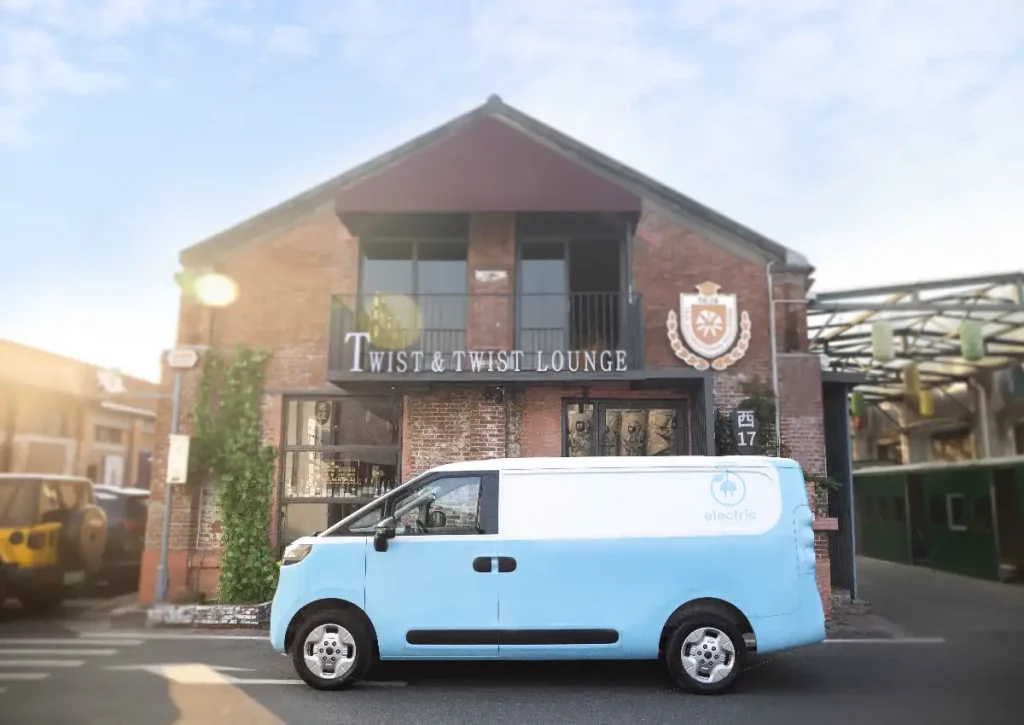
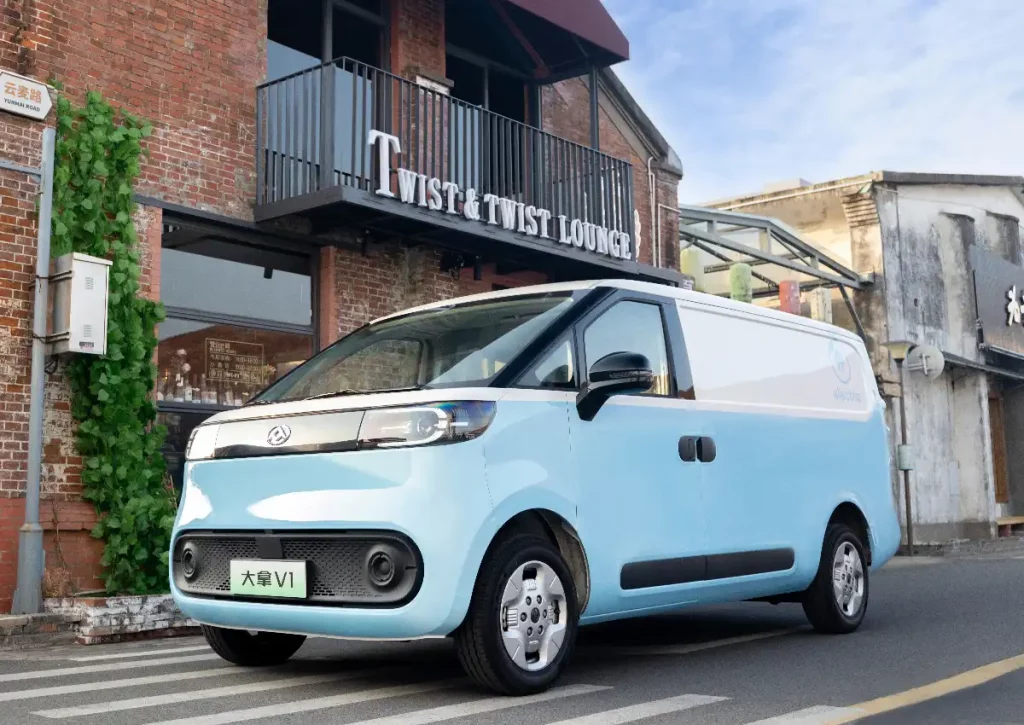
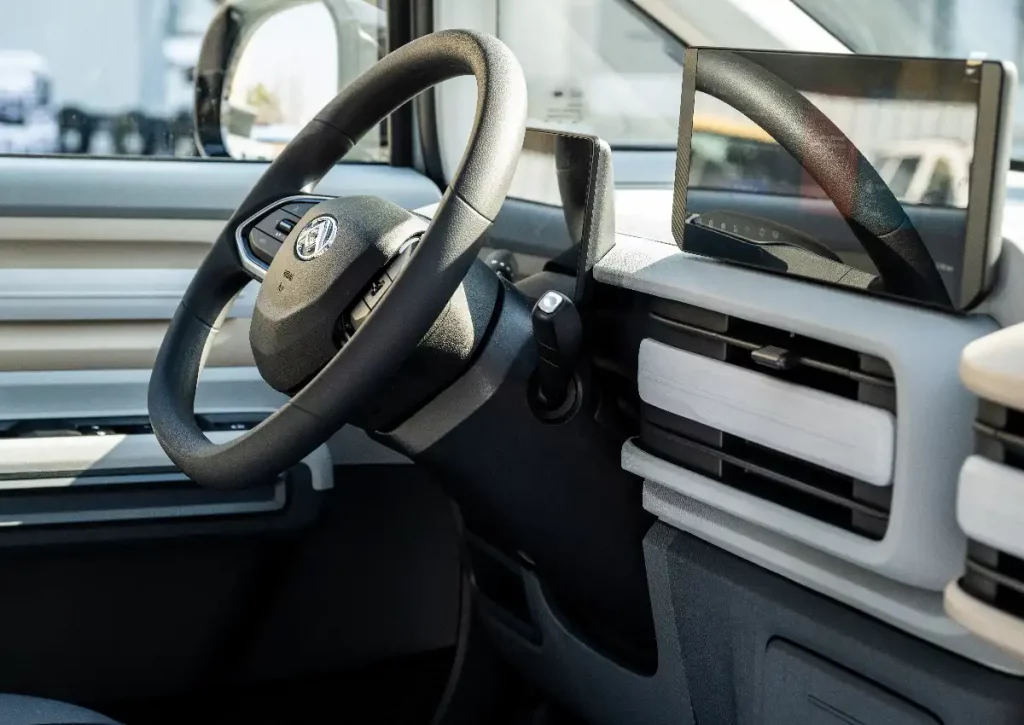
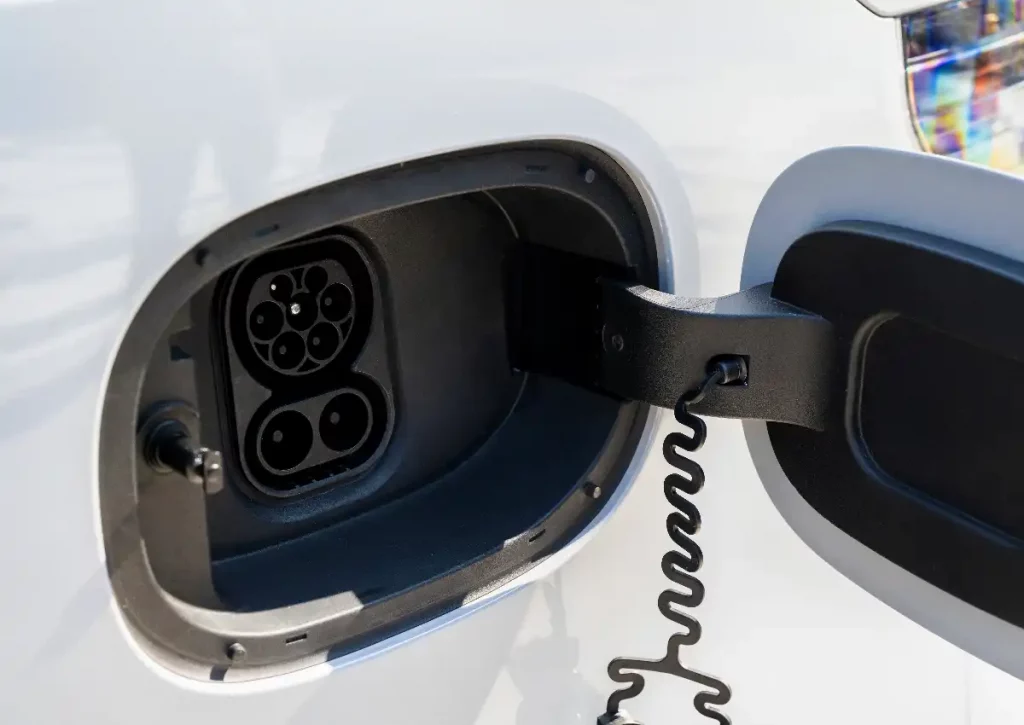
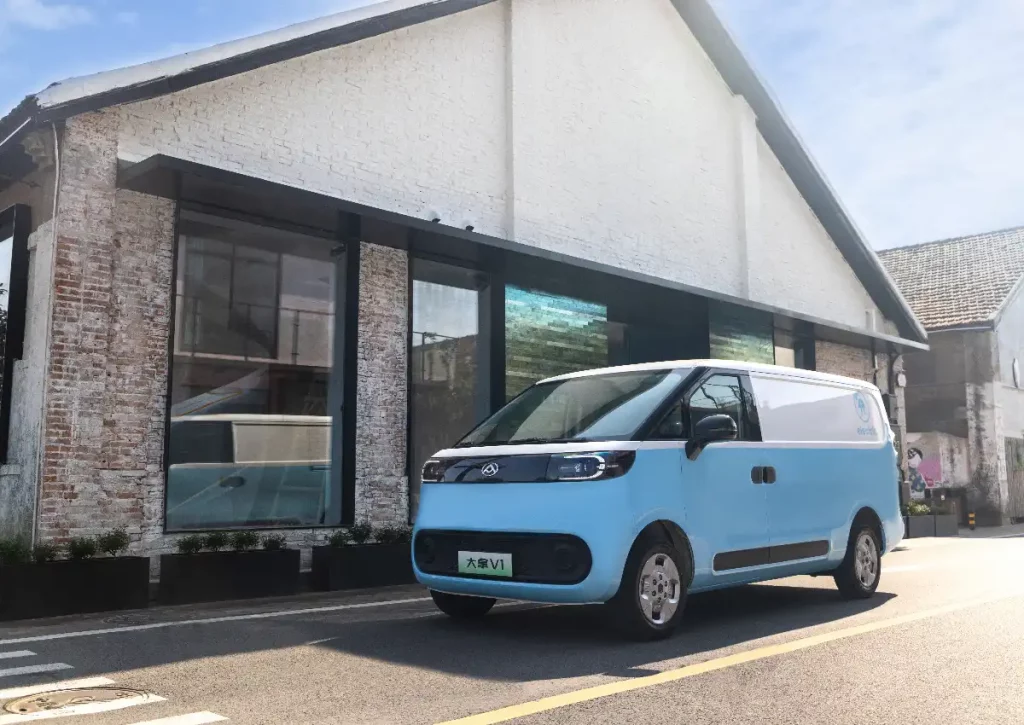
Maxus has unveiled its latest new electric vehicle in the UK with the announcement of the Maxus eDeliver 7 mid-sized electric van.
The Maxus eDeliver 7 all-electric van joins the Maxus models, the Maxus E Deliver 3 and Maxus eDeliver 9 as the range expands futher having recently added the Maxus T90EV pick-up truck and the Maxus Mifa 9 passenger car.
The new eDeliver 7 gets a 88kWh battery and is capable of a claimed 226 mile range. It will be available in three size configurations with a short wheelbase and long wheelbase, as well as a high roof option.
Payload will be up to 1200kg, while the smallest eDeliver 7 van has a capacity of just 5.9m3 and the largest up to 8.7m3.
Power comes from a 150kW electric motor producing 330Nm of torque at its peak.
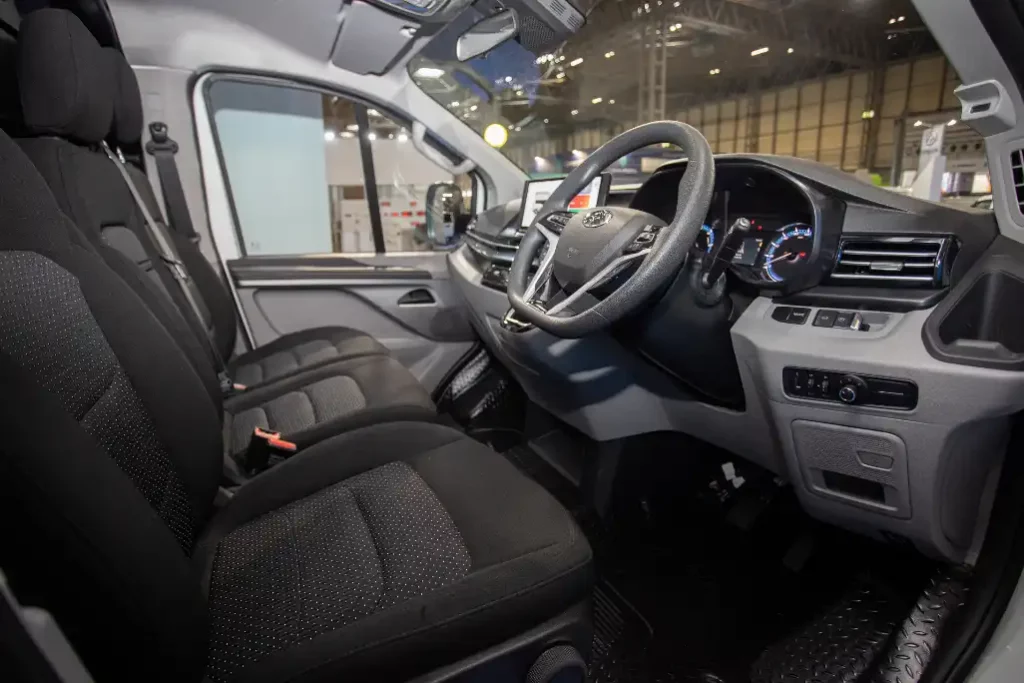
Estimates vary but more than two thirds of the world’s populations will be living in cities by 2050 – an increase of 13%, equating to roughly 1bn more people. As things stand, this poses a number of issues not least for air quality and noise pollution as scores of vehicles flood the cities to meet our needs whether it is for construction materials and equipment or goods for home delivery and healthcare.
While much of the urban population growth is expected in countries such as India, China and Nigeria, Europe and the UK are reacting to the role transport plays in pollution levels and are introducing stricter emission targets in cities and placing restrictions on the types of vehicles that will be allowed to enter the cities to counteract the rise.
Electrification is becoming a high priority for governments and fleets alike, but how will building materials, your weekly food shop and critical temperature vaccines all be moved about the urban environment. There’s now a growing need for converted electrified vehicles capable of moving such items and just like with combustion engine products it will be chassis cab vans from bodybuilders that will be filling the void.
“We’re constantly electrifying our vans, and we always keep an eye on our customer requirements. The requirements regarding bodies and conversion are as diverse as the sectors that use them,” explains Markus Reis, Mercedes-Benz Vans product manager.
While there are no limitations as to where an electric vehicle might be used and what sectors are likely to operate them first, blue chip companies are leading the way and it’s no surprise that the booming home delivery segment is a willing customer.
“We have both N1 and N2 vans of the E Deliver 9 being built for Tesco,” explains Mark Barrett, MAXUS general manager. Having already supplied chassis cab versions of its previous generation large electric van, the EV80, to a number of fleets, MAXUS has been able to develop their new E Deliver 9 model to better cope with the demands imposed by fridge units, tail lifts and other auxiliary equipment.
“One of the things for us, is the early planning with the customer at how we integrate the fridge and the base vehicle together. We engage with the factory, and we have 3kW to 5kW of additional spare power from the battery which is going through a controller unit, and the fridge connects to that. For other auxiliary equipment, like tail lifts, it can come from the standard 12v battery,” explains Barrett.
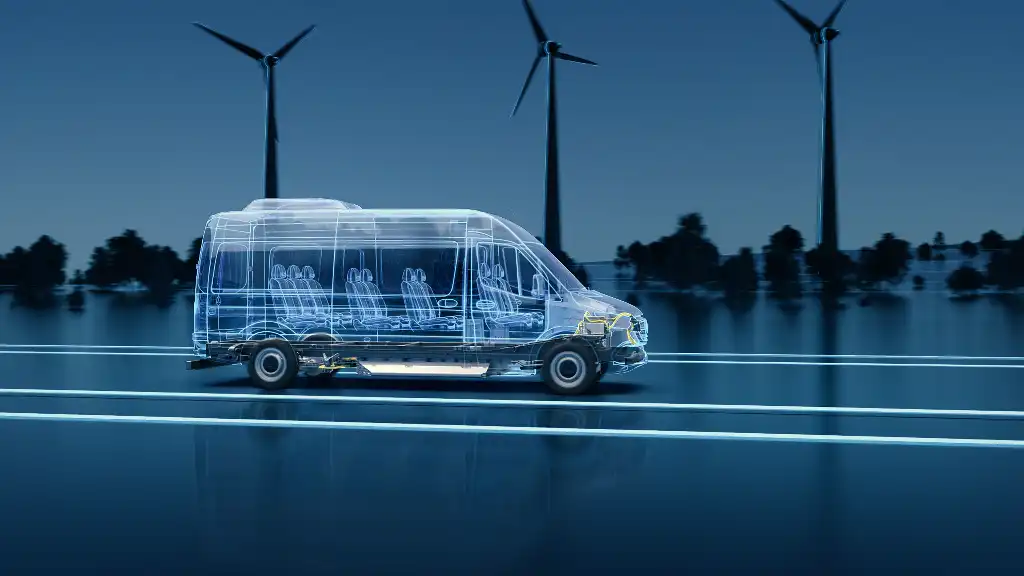
Not all manufacturers will permit a direct power feed from the traction battery, which can lead to having separate power supplies in addition to the 12v battery to run ancillary devices, however, for the most part the power consumption of the equipment is either relatively low, or confined to short bursts.
“Of course it impacts on the range,” continues Barrett, “but surprisingly very little. On maximum drawdown you’re looking at 10 to 15 minutes to get it down to chill or frozen. That will probably done while still on charge and once its down to temperature it doesn’t take much [to maintain the temperature]. Heating the cabin of the van will in theory use more van than the fridge.”
Veteran of the electric light commercial vehicle market Renault, whose Master ZE large van has recently been rebranded as the Renault Master E-Tech, already has an electric Luton low-loader van on sale and is, according to Renault LCV conversions manager Mark Waite, experimenting with other prototype bodies and battery top-up solutions.
“The only complexity we have with electric vehicles is how you treat electrical connections because it’s forbidden to take any electrical connections off of the Master’s traction battery. You still have the 12v electrical system to connect to, so the question is when do you connect to that [or a separate supply]. We’ve prototyped a ZE tipper and will go into a test phase to see what impact it has on range. We’re not expecting it to have a dramatic effect because the electrical draw for raising a tipper bed happens for a 20-second blast. Putting a tail lift on a Luton box van, you’ve got the same issue where the electrical draw would impact the range of the vehicle. In that instance, we’re doing a trial with fitting solar panels to the roof to assist in making sure the main 12v battery is topped up, because in reality you’re going to use a tail lift more than a tipper.”
Manufacturers are in fact already working on a solution for more power-hungry equipment with both Iveco and the Stellantis brands confirming to Van Reviewer that they are working on electric PTO solutions for their eLCVs.
“We’ve been working with bodybuilders for about two years,” says Mike Cutts, Iveco business line director (LCV) about the 2022 model-year electric Daily van.
“We will focus on the chassis models with an electric PTO offer, making sure there’s enough transferable power to meet the applications whatever you want to put on the back,” Cutts explains.
Presently, however, Stellantis bodybuilder relations manager, Hervé Criquy, believes that the vehicle’s main battery can be used to power most equipment and with only a small decrease in range from the equipment’s power draw. “We believe the HV (high voltage) battery can supply enough power to any conversion appliance, without major impact on the range due to the consumption. For example with fridge solutions, the impact of a normal delivery round trip shall be of -5 to -8% on the range,” Criquy says.
When it comes to limitations on what body can be applied to an electric van both Barrett and Waite believe there are actually no limits. With the exception of the placement of battery cells if they’re located within areas a bodybuilder would want to drill in to for mounting, neither sees any issues – a point which Mercedes has ably demonstrated by converting an ambulance on to an Mercedes-Benz eSprinter chassis.
“The industry is quite good at thinking how to overcome potential drawbacks with electric systems. If you think of refrigerated vehicles, the refrigerated vehicle industry has developed its own lithium-ion battery systems to power electrical refrigeration units,” Waite says.
Barrett agrees, and goes so far as to say that electric versions can outperform their diesel equivalents.
“I think any of the applications on a diesel would work on electric. Even when it comes to van payloads as we have that flexibility in the UK with the uprated payload. It has killed that issue. We’re plated at 4050kg on the N2, so you’ve actually got a better payload.”
Vehicle range, reduced payload and invariably the purchase cost may all be valid areas of concern for potential electric van purchasers, but when it comes to equipping this new era of vehicles with the bodies and equipment we’ve become accustomed to there’s no reason to be alarmed. Indeed, as technology improves, the efficiency and productivity of these vans may well see bodied EVs becoming more practical and cheaper to run than their ICE equivalents.
How to build onto an electric van chassis
Like with any build its best to read the instructions. Manufacturers provide their partners with details technical documents and these should be your first port of call. An accredited body builder is best placed to do the work. If in doubt, consult the experts.
The priority is to not damage the safety cell of the vehicle or its battery. Many electric vehicles have defined points where bodies, cranes or tail lifts can be fixed to. These will likely be the same position as any ICE equivalent vehicle.
If adding additional powered equipment don't assume you can use the van's own electrical system. Some vans will make provisions for you to tap into an electricity supply, other won't. More power hungry devices might require a Power Take Off unit and ePTOs are becoming increasingly common.
Maxus has announced Euro Commercials as the latest dealer to join its network in the UK.
The South Wales-based commercial vehicle dealer is celebrating its 40th year in business and operates from five different locations in Cardiff, Newport and Swansea. Euro Commercials is best known as a Mercedes-Benz dealer. Several Mercedes dealers have added Maxus to their portfolio in recent years including Rygor and Northside Truck & Van.
Euro Commercial's Cardiff dealership, on the Ipswich Road, will become the centre for Maxus products with sales, servicing and aftersales services to Maxus customers.
The expansion of the Maxus dealer network with the addition of Euro Commercials brings the total number of Maxus dealerships in the UK and Ireland to more than 50.
Maxus has previously stated that it believes a network of around 60 dealerships would be the correct number for the UK and Ireland, and has said that the mix between its dealers with light commercial vehicle experience and heavy duty trucks is a strength of the broadening network.
The Maxus range currently includes the diesel-powered Maxus Delivery 9 as well as electric-only Maxus eDeliver 3 and Maxus eDeliver 9 vans. Maxus has also launched a new electric powered pick-up truck. The Maxus T90EV is the first electric pick-up truck on sale in the UK. It is currently only available as a 4x2 but there are plans for a 4x4 version to be launched in 2024.
A new model, the Maxus eDeliver 7, is also scheduled to join the Maxus range along with the smaller Maxus eDeliver 5.
Mark Barrett, general manager of Harris Maxus, said: “We are excited to partner with Euro Commercials to bring a new Maxus dealership to Cardiff. Euro Commercials already works with impressive global brands such as Mercedes-Benz and is known for fantastic service and customer care. We look forward to a successful partnership in the years ahead.”
There has been an huge jump in the number of small electric vans being brought to market in 2022 and with technology moving so quickly it’s hard to keep up.
Buyers are understandably wary of committing to new technologies and their capabilities can vary widely.
Van Reviewer is here to make it easier for you, though, with a round-up of the best small electric vans in 2022. Despite out focus being on the best small electric vans of 2022, they do still come in a wide variety of shapes and sizes, there’s also cheap and cheerful to proper premium passenger car-based electric vans and hybrids too.
We rank them in order of what we like best, but to be honest they’re all really good – so check out our little verdict on each.
We'll start off with our second choice on the list....
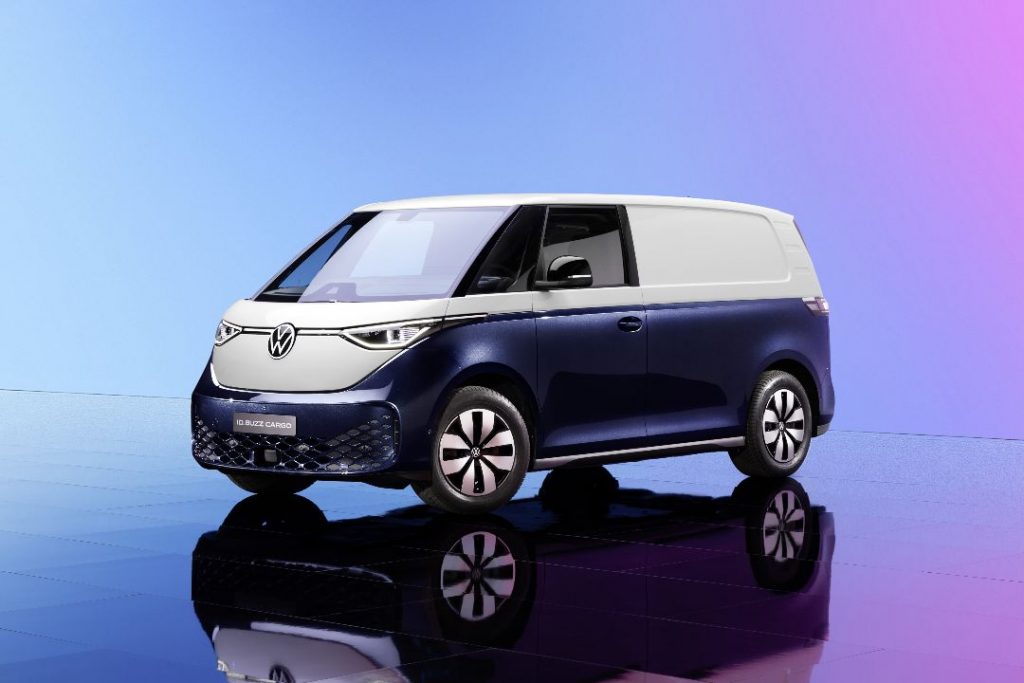
The Volkswagen ID Buzz Cargo is a brand-new electric van that takes its inspiration from the classic Volkswagen Type 2 campervan.
It sits between the Volkswagen Caddy and the Volkswagen Transporter T6.1 in the Volkswagen range in terms of its size and is built on Volkswagen’s shared MEB electric drivetrain platform. Despite being a van, with a load volume of up to 3.9m3 and 650kg, the ID Buzz Cargo actually borrows many of its features from Volkswagen’s passenger car models including the Volkswagen ID.3 and the Volkswagen ID.4 passenger cars.
A 150kW motor powers the van, producing 310Nm of torque in the process. There is currently just one battery option, a 82kWh unit providing a claimed range of up to 256 miles. Charging from 5% to 80% can be done in less than 30 minutes thanks to a maximum charge rate of up to 170kW on a DC charger.
For those needing more payload, a smaller battery pack size is likely to be added to the line-up reducing range but pushing capacity to around 750kg.
Two trim levels are available, Commerce and Commerce Plus, with entry-level models receiving a high level of equipment including LED headlight, a heated driver’s seat, front and rear parking sensors, 10” touchscreen and wireless App-Connect for Apple CarPlay and Android Auto. Commerce Plus models get Adaptive Cruise Control, keyless entry, Park Assist Plus with memory function which allows you to effectively record difficult parking manoeuvres to be automatically repeated. There are also safety features including driver assistance systems like Travel Assist, Lane Assist, Side Assist and Emergency Assist.
Prices start from £38,125 and includes three services and an MoT.
VERDICT: The Volkswagen ID Buzz Cargo’s biggest problem is its price but if you can get over that it is a brilliantly trendy, practical and accomplished van. It’s really a passenger car at heart, but unlike so many where the seats are removed and some blacked out windows added, the ID Buzz Cargo has been co-developed as one so it gets the best of both worlds. Loads of smart tech, super-fast charging, and reasonably good at both volume and payload. It's very nearly the best small electric van of 2022.
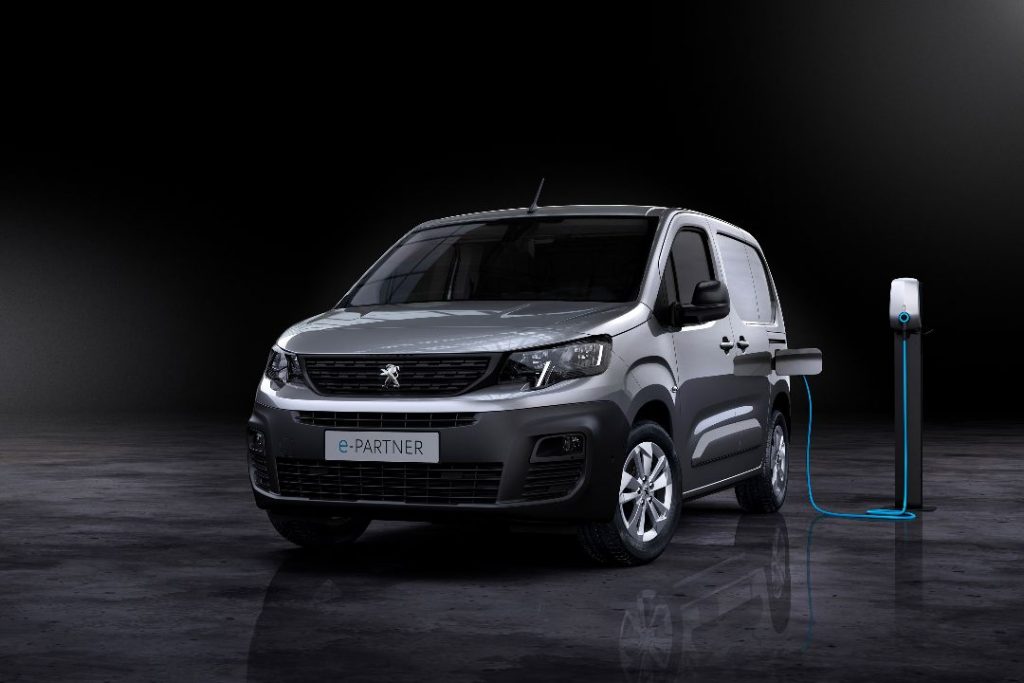
The city vans of Citroen, Peugeot, Toyota and Vauxhall have taken the successful underpinnings of the medium-sized electric van from Stellantis and applied it to the compact packaging of their small van range.
Built in France for Stellantis siblings Citroen, Peugeot and Vauxhall and also produced on behalf of Toyota, the van leads the small van sector with a 171 mile range from a 50kWh battery pack and is paired to a 100kW (136bhp) motor producing 260Nm of torque. Despite being small, the vans offer a load capacity of 4.4m3 thanks to a load-through bulkhead with folding passenger seat which extends the 3.3m3 and 3.9m3 capacities of the standard and long wheelbase vans.
The four vans can also have a very respectable payload of up to 800kg and have a towing capacity of 750kg. For added versatility, they can be specified with a E-Power take off system to power conversions such as fridge units. Charging can be carried out using 100kW charger, taking the battery from zero to 80% in 30 minutes.
The van’s comfortable cabin is focused around the driver with an angled 8in infotainment and navigation touchscreen, and includes several premium features like wireless phone charging and a Surround Rear View system giving a 360-degree view around the van. In total there are 18 driver assistance systems designed to make the van safer for both drivers and other road users.
Prices start from around £27,000 depending on the brand.
VERDICT: These small vans have been on sale for more than a year, coming to market in the autumn of 2021 but they still manage to deliver what the electric audience needs. They’ve not been left behind by the changes in technology either, with powerful motors, decent battery range and the option of both standard and high specification models.
If you want a decent all-rounder these three make a good bet, and the Toyota even comes with a longer warranty.
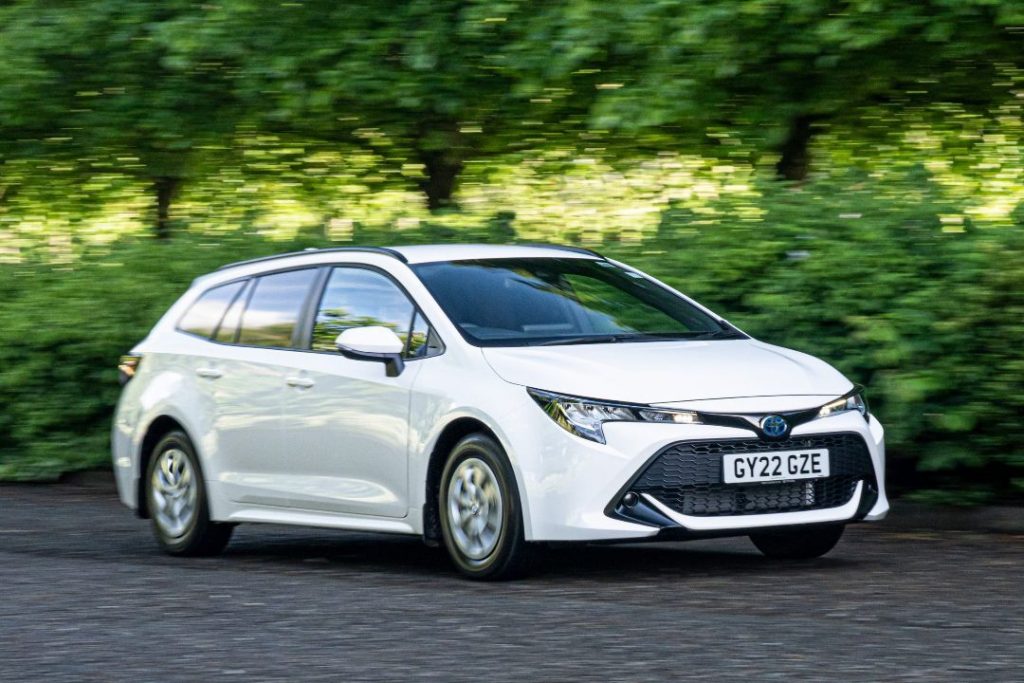
It’s been years since the Astravan disappeared from sale but the Toyota Corolla Commercial Hybrid van more than makes up for the shortfall.
Based on the Corolla Touring Sports estate passenger car, it is a full self-charging hybrid electric van. It looks, feels and drives like a car, but has a healthy 1.3m3 loadspace area in place of the rear seats.
Power comes from a 1.8-litre petrol engine and is paired to a 53kW electric motor, together the petrol hybrid Corolla Commercial produces up to 90kW (120bhp) and 142Nm of torque.
It’s the only engine choice and there’s also only one trim level but the interior is far from your typically commercial vehicle.
The Corolla Commercial gets a decent level of equipment including heated seats, dual-zone climate control and a reversing camera. There’s also LED headlights as standard. When it comes to safety, the Corolla Commercial Hybrid isn’t short on features. It gets adaptive cruise control, high beam assist headlights and lane keep assist as standard. Lane Trace Assist also helps to keep the van in the centre of the lane even while turning slight bends, and there’s Road Sign Assist to remind you of the speed limits with an audible or visual warning.
In the rear, the loadspace floor gets a rubber lining and there is a full-height steel bulkhead to protect the front seat occupants. There’s also an interior light and a 12v power outlet but the important figure is the 425kg payload and 750kg towing capacity.
Prices start from £22,149, excluding VAT.
VERDICT: A self-charging hybrid has managed to sneak into our best small electric vans of 2022 review but with good reason. That’s because the Toyota Corolla Commercial Hybrid is one hell of a package.
It’s a car to van conversion like any other with some questionable sticky window coverings but average fuel consumptions knocking on the door of 60mpg in the real world can’t be sniffed at.
It doesn’t suit everyone, but it brings back a niche segment and adds an electric spin to it. We’re grateful for the effort.
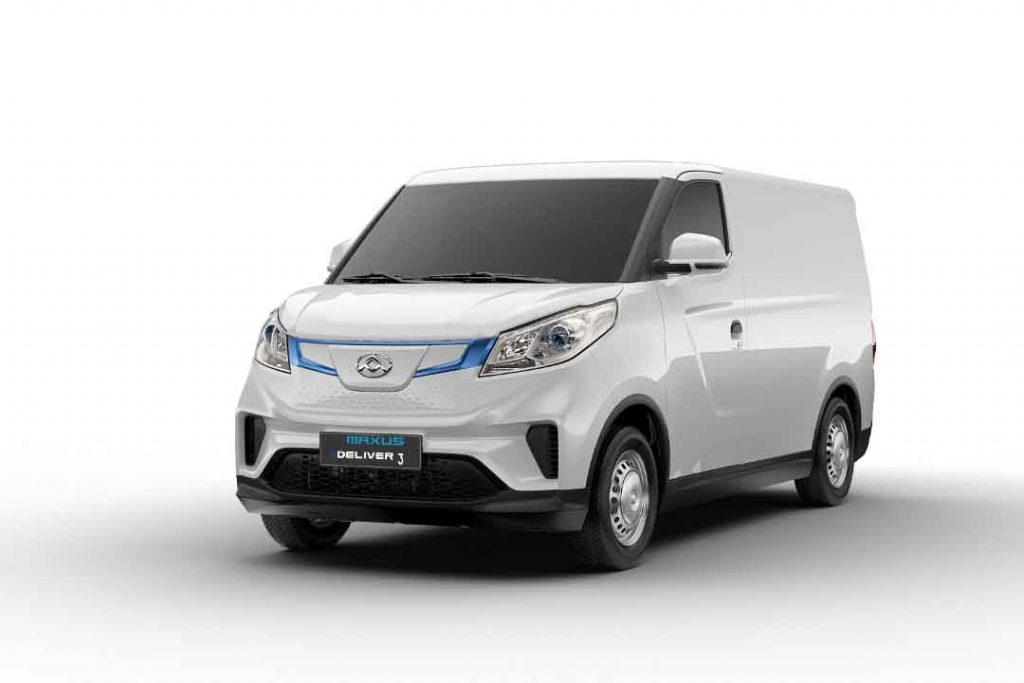
Arguably the first electric van to be launched that was conceived purely as an EV, the Maxus e Deliver 3 was nevertheless a big departure for Chinese-owned Maxus whose line-up had previously consisted of both diesel and electric models.
Designed from the ground-up as a pure electric van with a heavy focus on its aerodynamic performance, the e Deliver 3 has a claimed range of up to 213 miles for its WLTP city range and 151 miles for the combined WLTP standard. It has the option of two battery packs with either 35kWh or 50kWh cells and is paired to a 90KW motor producing 255Nm of torque.
It can carry up to 945kg of payload and despite only being available in a short wheelbase has a volume of 4.8m3. It is the smaller sibling to the large electric van Maxus E Deliver 9 and Maxus E Deliver 7.
Charging times using a DC rapid charger will see the battery level go from 5% to 80% in just 45 minutes, while a three-phase 11kW AC charge will take around five hours.
Standard features include air conditioning, built-in Sat Nav, smartphone mirroring with Apple CarPlay and Android Auto compatibility as well as USB and Bluetooth connectivity.
Operators can also have the e Deliver 3 as a chassis cab and can get real-time telematic data through a partnership with Geotab.
Its most appealing feature, however, is its price with models starting from just £27,000 with a government grant.
VERDICT: We’d love to put the e Deliver 3 much higher in our list of the best small electric vans you can buy in 2022 but it’s not quite the complete package. The battery range is impressive, and there’s adequate power from the motor, but its all the bits and piece in the cabin that let it down. An infotainment system that is frustrating (when it works) and a other little software gremlins too.
Launched in 2020 it fills a natural hole left by the Nissan eNV200 which is definitely a good thing, but it can’t match the finesse of the newer models.
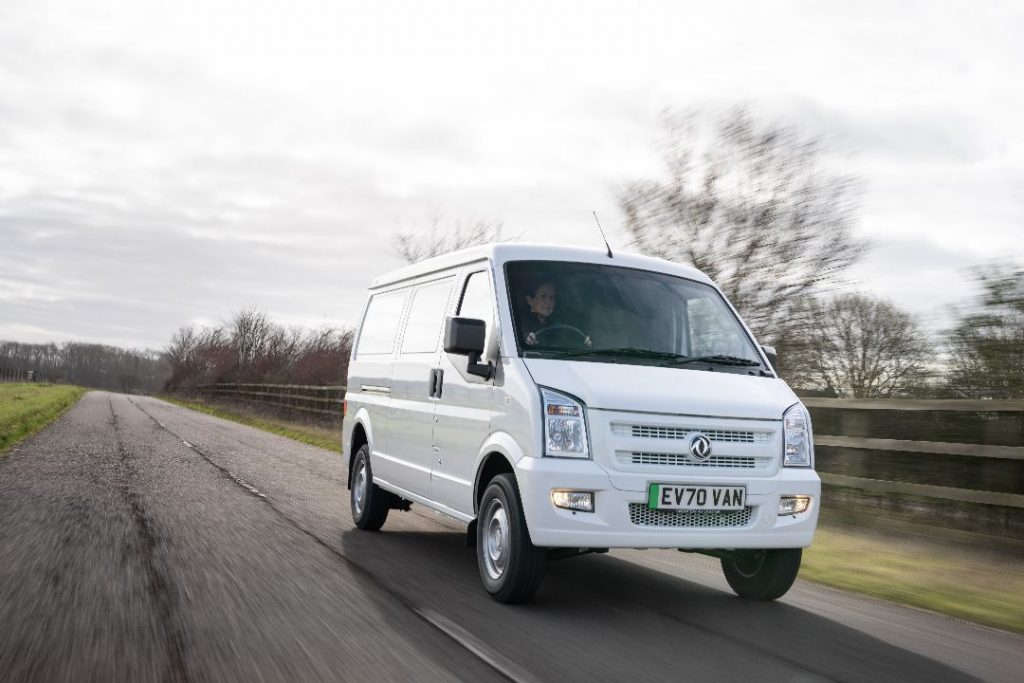
Chinese-made DFSK vans have made a comeback in the UK through importer Innovation Automotive with the quirky midi-van offering a cheap entry-level price to electric van ownership.
The DFSK EC35 looks like a typical Japanese-style microvan with high sides and a narrow width of just 1680mm. It’s unusual proportion don’t mean it is lacking in space with a maximum loadspace volume of 4.8m3 and an equally impressive payload capacity of 1,015kg thanks to its lightweight 1585kg kerbweight. It has a hinged rear tailgate and gets twin sliding doors as standard.
Power comes from a 60kW (80bhp) motor paired to a 39kWh lithium-ion battery with 200Nm of torque. While options are few and far between, one thing you can choose is the maximum speed limit of the van, with a 50mph limited model or a faster 62mph van. Depending on which version you choose will dictate how far you might be able to travel with a claimed range of 101 miles or 166 miles, according to the WLTP testing cycle, for the slow and fast versions respectively. The DFSK EC35 is able to be charged at a maximum rate of 40kW with the battery level going from zero to 80% in around 60 minutes. Topping up the battery to 100% on a 40kW charger will take 90 minutes, while charging from a 7kW wall box will take 6 hours.
Prices start from £20,999 excluding VAT.
VERDICT: Being entirely honest with you, the DFSK is only on the list out of courtesy. It’s not a particularly good van.
But, it will certainly do the job for the right sort of person. If you need to move things around at a walking pace, don’t want to go all that far or need to charge up that often it might just be the van for you.
If you spend more time out of the van than in it, then give it a chance. The price tag is too good not to consider it.
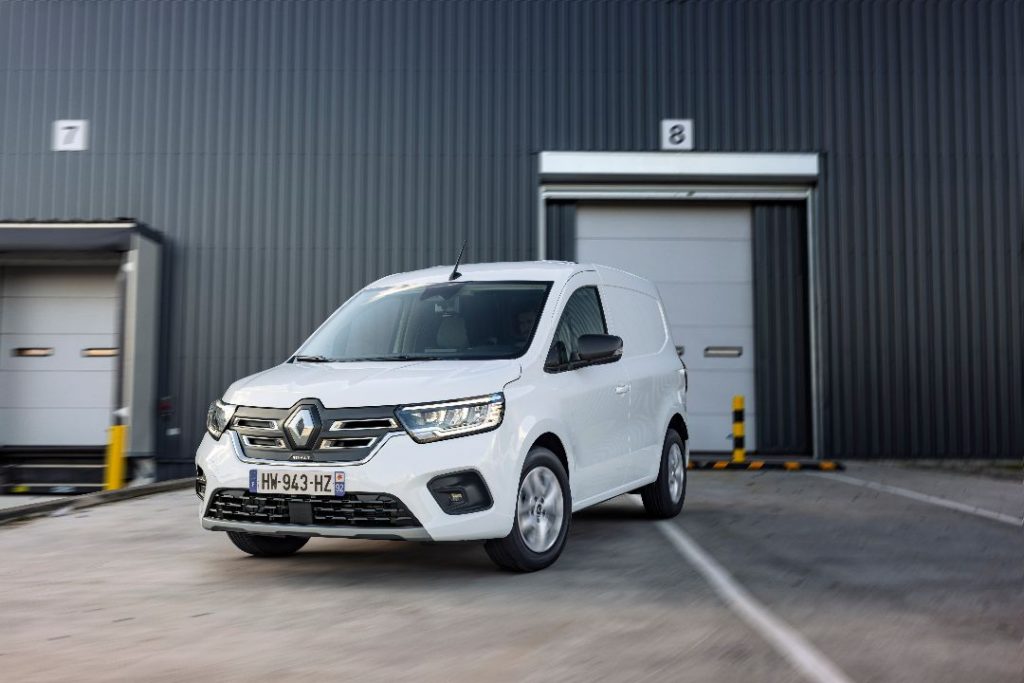
The Renault Kangoo is the oldest and most established name in the small electric van field but the latest version shares only its name with the trailblazer model launched in 2012.
The latest van returns with a new E-Tech name to reflect the rest of the electrified Renault models and is accompanied by two cousins with versions from Mercedes-Benz and Nissan. The three models offer a different take on the electric city van, with Mercedes opting for a more upmarket interior and more standard safety systems than the Renault, while Nissan plays off its warranty support and value.
All three vans, however, use the same 90kW motor paired to a 45kWh battery pack. Range for the vans is 186 miles, while charging can be carried out using an 80kW supply to add more than 100 miles in less than 30 minutes. Slower 22kW charging is also possible as well as a from domestic single-phase 7kW supply though a wallbox which is said to take six hours.
The van is available in two wheelbase lengths with the standard van having a 3.9m3 load volume and the long-wheelbase model up to 4.9m3 of capacity. Payload for regular vans will be up to 600kg but thanks to a higher gross vehicle weight the larger models can transport up to 800kg. They also have a 1,500kg towing capacity.
Prices start at around £30,000 for the Nissan version.
VERDICT: The diesel Renault Kangoo and Mercedes-Benz Citan are both excellent vans, and while the Nissan Townstar Electric is only available as a petrol model, the real strength of these models is the electric version.
Quiet, comfortable and way bigger than the previous generation vans, the Kangoo E-Tech, eCitan and Townstar electric really are the best small electric vans of 2022.
In summary, there's a large amount of choice in the small van market at the moment, and there's bound to be more with a Ford E-Transit Connect likely to be added to Ford's electric van range.